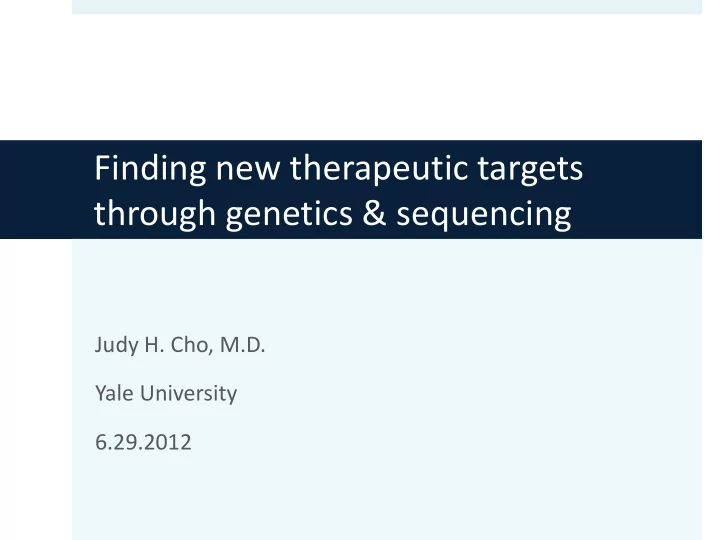

Finding new therapeutic targets through genetics & sequencing Judy H. Cho, M.D. Yale University 6.29.2012
Overview Examples from inflammatory bowel disease IL-23 pathway NOD2, mycobacterial diseases, & innate immune cells TNF pathway Systematically leveraging high throughput sequencing to prioritize new targets Phenotype driven Genotype (Encode data) driven
The IL-23 pathway in immune- mediated diseases
Multiple signals in IL23R gene region: uncommon protective Arg381Gln allele 0.5 Minor allele frequencies, CD cases Gene or locus IL23R 0.4 NOD2 5p13 0.3 ATG16L1 IL23R IBD5 0.2 0.1 Arg381Gln 0.0 0 1 2 3 4 Allelic odds ratio Risk Protective
IL-23 signaling 5/7 members of the (Th17 cells) primary IL-23 pathway IL23A(p19) IL12B(p40) associated in IBD chr12q13 chr5q33 Cytokine * Th17 cells: Patrol mucosal surfaces Fungal and bacterial defense * Receptor IL12RB1 IL23R chr19p13 chr1p31 * * * IBD associated JAK2 TYK2 chr9p24 chr19p13 STAT3 * chr17q21
Arg381Gln protective allele in IL23R is a loss- of-function allele Anti-p40 treatment (blocks IL12/23): Approved in psoriasis IBD phase III studies ongoing Issues: How to block IL23 pathway? Blocking IL-23 alone vs. IL12/23?? Blockade at what level? Receptor? JAK?
NOD2, mycobacterial disease & innate immune cells
The Immunochip effort in IBD: a large scale international collaboration 38,565 cases, 37,747 controls 71 new loci 163 loci with genome-wide significant association (~1500 genes) Jeff Barrett Luke Jostins
163 loci improved network analysis—key role of directionality Microarray datasets 140 CD & IBD CD-specific TB-specific cis trans validation - Across numerous GWAS SNPs Pre-computed Display item tissues Genes in 59 cis cis eSNPs from Enrichment Modules to be eSNP loci multiple tissues - From liver, screened omental, subq - Human only Omental genome- CD genes Enrichment in green wide cis and trans Bayesian - Within GWAS module eSNPs network loci PPI & TF structural priors IBD subnetwork Causal regulators Omental microarray data Color-coded -Define nodes --Guide MCMC fitting subnetwork Color-coded Color-coded CD-TB overlap GO annotation TB co-expression GO pathways modules Top module: omental adipose (macrophage Eric Schadt Ken Hui enriched) from obese patients
163 loci improved network based analyses based on gene co-expression Co-expression modules: tracking similar gene expression based on large microarray datasets The co-expression module with the greatest enrichment of IBD-associated genes: 523 gene module in omental adipose tissue (macrophage-enriched gene expression )—value of direct ex-vivo tissue analysis NOD2 Gene in IBD- associated locus
NOD2-centric view of the submodule: 7 IBD- associated genes near NOD2 LGALS9 NOD2 Autophagy SLC11A1 IL10 Induced with Mtb infection VDR Modulates mycobacteriosis HCK M. tuberculosis susceptibility CARD9 SLC11A1 (aka NRAMP1) Vitamin D receptor DOK3 LGALS9 HCK: key for differentiation of M2 macrophages (anti- Highly correlated RNA expression inflammatory IL10) between NOD2, IL10 & HCK (hematopoietic cell kinase)
The TNF pathway
IBD is a TNF-mediated disorder TNF-overexpressing mice develop ileitis and arthritis Anti-TNF is a highly effective treatment for IBD GWAS: multiple TNF-mediated signals NF-kB (NFKB1, REL, RELA, TNFAIP3) TNF: crucial in pathogen eradication—reactivation of tuberculosis a side effect of anti-TNF therapy
Molecular integration of TNF and 3’UTRs: crucial role of kinetics/functional responses TNF A20 (TNFAIP3) CCL2—max association in 3’UTR Kinetics of gene expression: multiple ub/dub associations: NDFIP1, CPEB4, CUL2, UBE2L3, as well as TNFAIP3 (15 loci inolved (p < 0.001) Few AREs (<2), very stable mRNA Some AREs (2-4), moderately stable mRNA Many AREs (4-10), unstable mRNA Hao 2009
Systematically leveraging high throughput sequencing to prioritize new targets: phenotype to genotype (1) LOF, protective alleles as ideal therapeutic targets PCSK9 & CAD IL23R & psoriasis/IBD/ankylosing spondylitis CCR5 & HIV IFIH1 & T1DM? Value of sequencing Targeted re-sequencing of GWAS signals: enormous structure-function data useful for improved targeting
Systematically leveraging high throughput sequencing to prioritize new targets: phenotype to genotype (2) Early onset, severe cases: medical resequencing LOF IL10 pathway genes bone marrow transplantation New biology: Nick Volker—young boy with early onset IBD XIAP mutation (essential for NOD2- signaling) -omics data & systems biology RNASeq: improved quantification should improve predictive models Systematic interrogation of disease-associated transcription factors: ChIPSeq Cross-phenotype analyses: immune-mediated diseases & infectious diseases
Striking overlap of loci between diseases: the genetics of infectious diseases IBD loci 6/7 leprosy loci also IBD loci 6/8 MSMD genes NOD2 within IBD loci IL23R IL12B 82 TNFSF15 STAT1 RIPK2 IRF8 LRRK2 TYK2 53 C13ORF31 STAT3 IFNGR2 MSMD 82 82 Primary Immune-mediated immune diseases deficiencies MSMD, Mendelian susceptibiltiy to mycobacterial disease
Genotype to phenotype: rare coding mutations and gains of functional moieties
Genotype to phenotype: the Encode approach Covalent modifications: missense mutations & Glycosylation Phosphorylation Ubiquitination/sumoylation Regulation of expression Conserved sequences AU-rich elements: RNA-binding protein sites in 3’UTR TF-binding sites, miRNA-binding sites, splice sites Analysis and information dissemination: validity & magnitude of effects Bioinformatic probability vs. experimental validation Frequency, population specificity Distinguishing negative selection from drift
Acknowledgements NIDDK IBD Genetics Consortium Steven Brant, Richard Duerr, Dermot McGovern, John Rioux, Mark Silverberg, Mark Daly DCC: Phil Schumm, Yashoda Sharma, Clarence Zhang, Kaida Ning International IBD Genetics Consortium
Recommend
More recommend